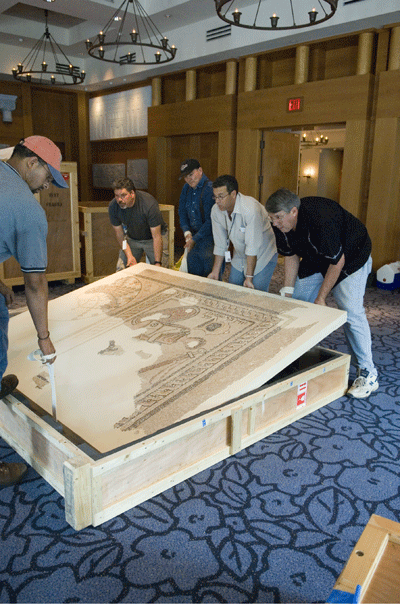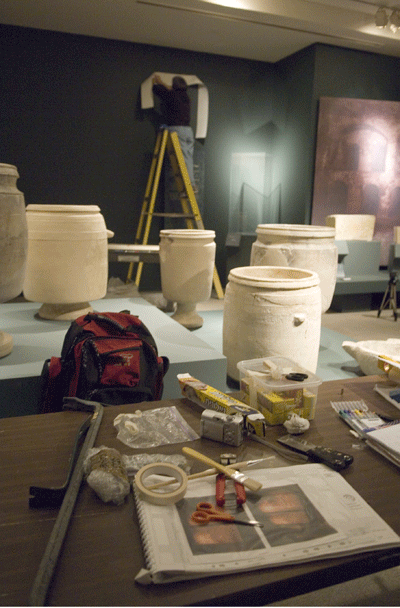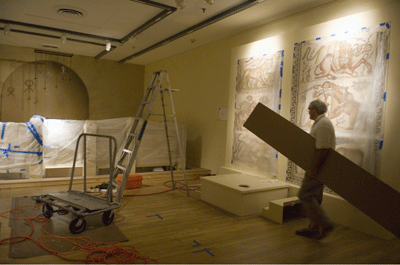
Emory
Report
June 11, 2007
Volume
59, Number 32

|
|
 |
|
Emory
Report homepage

June 11, 2007
‘Cradle of Christianity’ explores sacred artifacts
by carol clark
The Bible may be subject to interpretation, but some things are set in stone.
For instance, the Greek words on a fragment of a “keep out” sign from the Second Temple of Jerusalem, the setting for many pivotal New Testament events. This is the place where the Gospel of John describes Jesus overturning the tables of the money changers and driving out the cattle and sheep gathered there for sacrifice.
The stone fragment, chiseled with a warning to gentiles not to enter the sacred precincts of the temple, upon threat of death, is one of the artifacts included in the exhibition “Cradle of Christianity: Jewish and Christian Treasures from the Holy Land,” featured at the Carlos Museum June 16–Oct. 14.
“This same temple sign could have been seen by Jesus,” said Carl Holladay, Charles Howard Candler Professor of New Testament Studies. Holladay is one of several Emory religious scholars whose commentary can be heard on an audio guide to the exhibition.
“The exhibition is extraordinary because it gives you direct contact with the early first century CE — the time of John the Baptist, Jesus and Paul — and brings you through the fifth century, during a formative period in the development of both Judaism and Christianity,” he said.

The only archaeological find bearing the name of Pontius Pilate, the first Roman procurator of Judea, who sentenced Jesus to death by crucifixion, is included in the exhibition, along with a cast of a human heel bone
punctured by an iron spike — the only tangible evidence for the practice of crucifixion.
Everyday objects, such as ancient water vessels, of the type referred to in the New Testament story of the wedding feast at Cana, when Jesus was said to have turned water into wine, will help recreate the atmosphere of the time.

“It will be exciting, for Jews and Christians alike, to see the era that they have encountered liturgically become three dimensional through these artifacts,” said Michael Berger, associate professor in the Department of Religion and the Institute of Jewish Studies.
Brent Strawn, an assistant professor in Candler School of Theology, is looking forward to seeing the Temple Scroll, a fragment of a Dead Sea Scroll that is included in the exhibition. "From other texts, it seems that the community responsible for the Scrolls was originally expelled from Jerusalem, evidently in part because it objected to certain Temple practices of the time,” Strawn said. “The Dead Sea Scrolls give insight into one of the many sects within Judaism of the time, and Jesus and his movement can be compared and contrasted with that.”
The Carlos Museum is one of only three U.S. venues for the traveling exhibition of artifacts from the collection of the Israel Museum in Jerusalem. The artifacts are laid out chronologically, starting with the world in which Jesus lived, then moving into the development of early church art and architecture, and continuing through the fourth century, when the Roman emperor Constantine made Christianity the official religion of the empire. Many Jewish artifacts from the same era are also included.
The exhibition will show that, even for decades after the death of Jesus, Christianity and Judaism were in many ways indistinguishable, Holladay said. “Jesus and his immediate follower were Jewish, and the separation between Jews and Christians occurred much later. Paul the Apostle, for example, considered himself a devout and observant Jew until the day he died. He was an important Christian thinker, but he was
Jewish.”
For more information, visit http://www.carlos.emory.edu/.

All photos by Jon Rou
‘Walking the Bible’ author heads up ‘Cradle of Christianity’ events
A talk by best-selling author Bruce Feiler on Tuesday, June 26, leads off a series of events surrounding the “Cradle of Christianity” exhibit at the Carlos Museum. A native of Savannah, Ga., Feiler is an award-winning journalist and the author of seven books, including “Walking the Bible,” “Abraham” and “Where God Was Born.”
Other events set for the June 16 to Oct. 14 run of the exhibit include workshops and performances by master storyteller Jim Weiss; a Zero Church concert by the singing group The Roches and lectures by leading religious scholars.
Feiler’s talk is set for 7 p.m. at Trinity Presbyterian Church (3003 Howell Mill Rd). The event is free for Emory students, faculty and staff, but tickets are required. To reserve tickets and see details about the full calendar of events, visit the “Cradle of Christianity” Web site: www.carlos.emory.edu/cradle/program.php.
Feiler traveled 10,000 miles through the desert on the trail of the Five Books of Moses to research “Walking the Bible.” The book spent more than a year and a half on The New York Times best-seller list and became a PBS mini-series.
Following the 9/11 terrorism attacks, Feiler began researching his book “Abraham,” which delves into the story of the shared ancestor of Jews, Christians and Muslims.
“One of the most dominant questions in the world today is: Do biblical stories have relevance to contemporary life?” Feiler said. His Atlanta presentation is titled “The Holy Land: A Look at the Role of the Fertile Crescent in the Shared History of Judaism, Christianity and Islam.”
“I’ll talk about archaeology and what we can learn from the past to help with the religious tensions we have today,” he said. It’s a subject of interest to people of all faiths and even non-believers, he added.
TOP
|